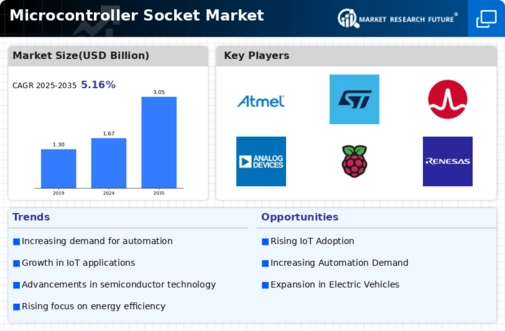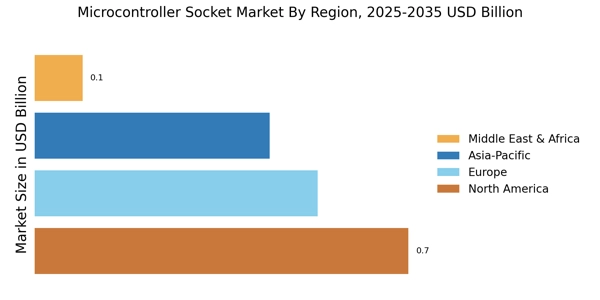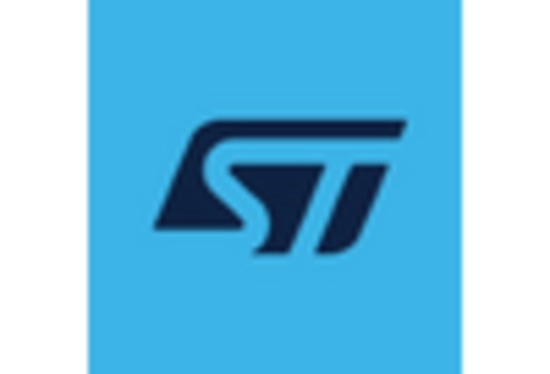Rise of Industrial Automation
The Microcontroller Socket Market is benefiting from the rise of industrial automation, which is transforming manufacturing processes across various industries. As companies strive for increased efficiency and reduced operational costs, the integration of microcontrollers into machinery and equipment is becoming commonplace. The industrial automation market is projected to reach approximately 300 billion USD by 2025, indicating a strong demand for microcontroller-based solutions. Microcontroller sockets play a crucial role in this ecosystem, enabling seamless communication between microcontrollers and industrial devices. This trend suggests that the Microcontroller Socket Market will continue to expand as more industries adopt automation technologies, creating a favorable environment for socket manufacturers.
Expansion of Automotive Electronics
The Microcontroller Socket Market is significantly influenced by the expansion of automotive electronics, which is becoming increasingly sophisticated. With the automotive sector embracing advanced technologies such as electric vehicles and autonomous driving systems, the demand for microcontrollers is escalating. In 2025, the automotive electronics market is anticipated to exceed 400 billion USD, reflecting a growing reliance on microcontroller-based systems for safety, navigation, and infotainment. This shift necessitates the use of microcontroller sockets, which are essential for connecting microcontrollers to various automotive systems. As automotive manufacturers continue to innovate and integrate more electronic components, the Microcontroller Socket Market is poised for substantial growth, driven by the need for reliable and efficient socket solutions.
Increasing Adoption of Smart Devices
The Microcontroller Socket Market is experiencing a notable surge due to the increasing adoption of smart devices across various sectors. As consumers and businesses alike seek enhanced connectivity and automation, the demand for microcontrollers, which serve as the brain of these devices, is on the rise. In 2025, the market for smart home devices is projected to reach approximately 100 billion USD, indicating a robust growth trajectory. This trend is likely to drive the need for microcontroller sockets, as they facilitate the integration of microcontrollers into smart devices, thereby enhancing functionality and user experience. Furthermore, the proliferation of smart appliances, wearables, and industrial automation systems is expected to further bolster the Microcontroller Socket Market, creating new opportunities for manufacturers and suppliers.
Growing Demand for Wearable Technology
The Microcontroller Socket Market is experiencing growth driven by the increasing demand for wearable technology. As health and fitness tracking becomes more prevalent, the need for microcontrollers in wearable devices is surging. The wearable technology market is expected to surpass 60 billion USD by 2025, highlighting the potential for microcontroller integration. Microcontroller sockets are essential for connecting microcontrollers to sensors and other components within wearable devices, facilitating data collection and processing. This trend indicates that the Microcontroller Socket Market will likely see a rise in demand as manufacturers seek efficient socket solutions to support the development of innovative wearable products.
Advancements in Communication Technologies
The Microcontroller Socket Market is poised for growth due to advancements in communication technologies, which are reshaping how devices connect and interact. The proliferation of 5G technology is expected to enhance the capabilities of microcontroller-based systems, enabling faster data transmission and improved connectivity. As the communication technology market is projected to reach over 1 trillion USD by 2025, the implications for the Microcontroller Socket Market are significant. Microcontroller sockets are vital for ensuring reliable connections in devices that leverage these advanced communication technologies. This trend suggests that the Microcontroller Socket Market will continue to evolve, driven by the need for innovative socket solutions that can support the demands of next-generation communication systems.

















Leave a Comment